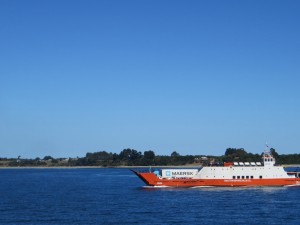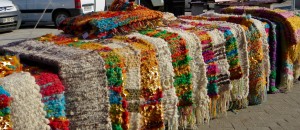 It’s a short ferry ride from mainland Chile to Chiloe Island. I lean over the railing to watch sea otters lounging in long strands of kelp, dolphin leap-frogging, pelicans skimming along a crest of surf. Snow-capped Osorno Volcano is visible alongside the Andes range in the distance. Wind tugs at the roots of my hair. Yes, the air smells of diesel fumes, but the sky is a pristine azure blue, without the brown haze we’ve become inured to seeing in cities around the world. Surrounded by this gift of exquisite beauty, I can’t help but feel joy.
It’s a short ferry ride from mainland Chile to Chiloe Island. I lean over the railing to watch sea otters lounging in long strands of kelp, dolphin leap-frogging, pelicans skimming along a crest of surf. Snow-capped Osorno Volcano is visible alongside the Andes range in the distance. Wind tugs at the roots of my hair. Yes, the air smells of diesel fumes, but the sky is a pristine azure blue, without the brown haze we’ve become inured to seeing in cities around the world. Surrounded by this gift of exquisite beauty, I can’t help but feel joy.
I’m on a tour of Patagonia with Overseas Adventure Travel (OAT). After disembarking, we walk along a boardwalk, home to hundreds of black-necked swans, oyster-catchers, cormorants, steamer ducks.  There are sixteen UNESCO World Heritage-recognized churches on the island, wooden-shingled structures build by local carpenters, blending Spanish Catholic and indigenous influences.
There are sixteen UNESCO World Heritage-recognized churches on the island, wooden-shingled structures build by local carpenters, blending Spanish Catholic and indigenous influences.  The houses, too, have their own distinctly shaped cedar shingles. Some are painted blue or green or orange, some left to the elements. The residents fish and raise sheep and sell woven handicrafts to tourists. Before the afternoon is out, we’ve already identified any number of modest one or two-story homes where my traveling companions and I would be happy to live, perched above the shoreline. It’s the kind of idyllic life easily romanticized.
The houses, too, have their own distinctly shaped cedar shingles. Some are painted blue or green or orange, some left to the elements. The residents fish and raise sheep and sell woven handicrafts to tourists. Before the afternoon is out, we’ve already identified any number of modest one or two-story homes where my traveling companions and I would be happy to live, perched above the shoreline. It’s the kind of idyllic life easily romanticized.
 But progress is coming to Chiloe Island.
But progress is coming to Chiloe Island.
In 2013, the Chilean government approved the building of a bridge across the Chacao Canal connecting Chiloe Island to the mainland. It will be the largest suspension bridge of its kind in Latin American. Four lanes, 8500 feet long. The project is an international partnership with Korea, Brazil, France, and Norwegian companies. At a cost of $680 million dollars.
We ask a crew of construction workers erecting new tourist signs what they think about the bridge. At first, we get a mix of shrugs and looks of resignation. But they have strong opinions. Sure, it’ll be good for a lot of them. More accessible medical care. Better schools. More tourists with money to burn. Our local guide wonders what that kind of money–more wisely spent–could do for the island. A woman in the craft market tells me it’ll be the end of their tranquil life. As if I’m allowed to have an opinion, that’s the part I feel sad about. My imagined dream-house, perched on the hillside will soon be surrounded with others just like it, crowding out my view. Obscuring paradise.
Those of us privileged enough to travel widely are racing around the world to see places that pretty soon won’t exist. At least not as we might wish to remember them. East Africa. The Maldives. The Alaskan tundra. The Taj Mahal. Like Chiloe Island, some changes are not due to climate change. Cuba, for example. I’m hoping to go there before progress changes that culture too. But who are we to say, others shouldn’t have what we have?
 The next day, we drive to the other side of the island, with a view of the Pacific Ocean. It reminds me of home–before the offshore oil rigs and time-share resorts and multi-million dollar homes teetering on the edge of a cliff. The coastline here remains largely untouched, protected by scrubby plants and a sandy cove. We are taken in motor boats out to a couple of rocky outcrops that are home to Humboldt and Magellanic Penguins. Within fifty feet, cameras in hand, we watch the penguins waddle up and down the rocks. Their gait is clumsy, awkward. You can’t help but applaud their scrappy determination.
The next day, we drive to the other side of the island, with a view of the Pacific Ocean. It reminds me of home–before the offshore oil rigs and time-share resorts and multi-million dollar homes teetering on the edge of a cliff. The coastline here remains largely untouched, protected by scrubby plants and a sandy cove. We are taken in motor boats out to a couple of rocky outcrops that are home to Humboldt and Magellanic Penguins. Within fifty feet, cameras in hand, we watch the penguins waddle up and down the rocks. Their gait is clumsy, awkward. You can’t help but applaud their scrappy determination.
 I wonder: do they sense what’s coming? Is there anywhere else for them to go?
I wonder: do they sense what’s coming? Is there anywhere else for them to go?
Fellow travelers and environmentalists. How do you define progress? What’s worth saving, just as it is?